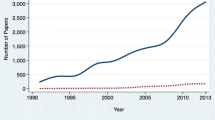Abstract
Overwhelming evidence indicates the strong adverse health impact of several personal behaviors, including smoking, immoderate use of alcohol, too little physical exercise, and excessive caloric consumption. These behaviors have arisen on a mass scale in the industrialized nations during the 20th century, thus generating the epidemics of our time. The macrosocial environment—specifically, new (relative) affluence, technological innovations, and commercialization—encourages these behaviors. To advance health, particularly in inner cities of America, a systematic approach to dealing with these major forces on health-related behavior is necessary. Such an approach is briefly outlined.
Similar content being viewed by others
References
Dublin LI, Marks HH.Mortality Among Insured Overweights in Recent Years. Reprint of paper read at: 60th Annual Meeting of the Association of Life Insurance Medical Directors of America; 11–12 October 1951.
Surgeon General's Advisory Committee on Smoking and Health.Smoking and Health. Washington, DC: US Government Printing Office; 1964; US Department of Health Education and Welfare. Public Health Service Publication 1103.
McGinnis M, Foege W. Actual causes of death in the United States.JAMA. 1993;270: 2207–2212.
Keys A.Coronary Heart Disease in Seven Counties. New York: American Heart Association; 1970. American Heart Association Monograph 29.
Dawber TR.The Framingham Study. The Epidemiology of Atherosclerotic Disease. Cambridge, Mass: Harvard University Press; 1980.
Morris JN.Uses of Epidemiology. 1st ed. London: Livingstone; 1957.
Blair S, Powell K, Bazzarre T, et al. Physical Inactivity. Workshop 5. American Heart Association Prevention Conference 3: Behavior Change and Compliance: Keys to Improving Cardiovascular Health.Circulation. 1993;1402–1405.
Breslow L, Breslow N. Health practices and disability: some evidence from Alameda County.Prev Med. 1993;22:86–95.
President's Commission on Health Needs of the Nation.Building America's Health. Vol. 1. Washington, DC: US Government Printing Office; 1951.
Antonovsky A. Social class, life expectancy and mortality.Milbank Mem Fund Q. 1967; 45:31–34.
Marmot MG, Smith GD, Standfeld S, et al. Health inequalities among British civil servants: the Whitehall II Study.Lancet. 1991;337:1387–1395.
Pappas G, Green S, Hadden W, Fisher G. The increasing disparity in mortality between socio-economic groups in the United States, 1960 and 1986.New Engl J Med. 1993;329: 103–107.
Breslow L. Occupational and other social factors in the causation of chronic disease.J Hygiene Epidemiol Microbiol Immunol. 1960;4:269–277.
Berkman LF, Syme L. Social networks, host resistance and mortality; a nine-year follow-up study of Alameda County residents.Am J Epidemiol. 1979;109:180–204.
Author information
Authors and Affiliations
Rights and permissions
About this article
Cite this article
Breslow, L. Behavioral factors in the health status of urban populations. J Urban Health 75, 242–250 (1998). https://doi.org/10.1007/BF02345092
Issue Date:
DOI: https://doi.org/10.1007/BF02345092




